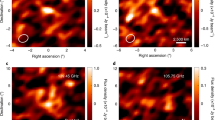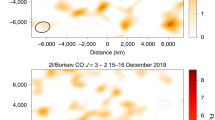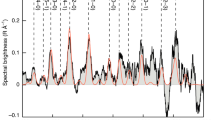Abstract
A large flux of small comets in the inner Solar System1 might produce a recognizable Lyman-α signature near 1 AU (ref. 2). We have now examined spectra obtained by the ultraviolet spectrometer (UVS)3 on the Voyager 2 spacecraft between 1 and 2.5 AU and have found evidence for a very large number of 'cometesimals' with radii between a few metres and a few tens of metres in the neighbourhood of the Earth. The evidence consists of a component in the interplanetary Lyman-α radiation that decreases rapidly (between r−3 and r−4) with heliocentric distance. The Lyman-α emission rate in a direction normal to the Sun-spacecraft line and downwind (the anti-apex direction) in the interstellar wind at 1 AU is 640 rayleighs, of which our analysis attributes 477 R to the interstellar medium (ISM) and 163 R to another source. Despite this result we propose that this source consists of comets of a different sort than those proposed by Frank et al.1 and with a flux seven orders of magnitude smaller. We propose that these cometesimals are ice-coated, porous, low density refractory boulders that may be the building blocks of ordinary comet nuclei4. We show that the cometesimals required to produce the observed Lyman-α emission can also account for all the lunar craters with diameters between 200 m and 1,500 m produced during the past 3,200 million years at sites such as Mare Tranquillitatis.
This is a preview of subscription content, access via your institution
Access options
Subscribe to this journal
Receive 51 print issues and online access
$199.00 per year
only $3.90 per issue
Buy this article
- Purchase on Springer Link
- Instant access to full article PDF
Prices may be subject to local taxes which are calculated during checkout
Similar content being viewed by others
References
1. Frank, L. A., Sigwarth, J. B. & Craven, J. D. Geophys. Res. Lett. 13, 307–310 (1986). 2. Donahue, T. M. Geophys. Res. Lett. 14, 213–215 (1987). 3. Broadfoot, A. L. et al. Space Sci. Rev. 21, 183–206 (1977). 4. Gombosi, T. I. & Houpis, H. L. F. Nature 324, 43–44 (1986). 5. Hinteregger, H. E. Adv. Space Res. 1, 39–52 (1981). 6. Thomas, G. A. Rev. Earth planet. Sci. 6, 173–204 (1978). 7. Neukum, G. & Wise, D. V. Science 194, 1381–1387 (1976). 8. Schmidt, R. M. & Housen, K. R. Eos 67, 1078–1079 (1986). 9. Mendis, D. A. Proc. 20th ESLAB Symp. Exploration Halley's Comet (ESA SP-250, 1986). 10. Fanale, F. P. & Salvail, J. R. Icarus 60, 476–511 (1984). 11. Horanyi, M. et al. Astrophys. J. 278, 449–455 (1984). 12. Bohlin, R. C. Astr. Astrophys. 28, 323–326 (1973).
Author information
Authors and Affiliations
Rights and permissions
About this article
Cite this article
Donahue, T., Gombosi, T. & Sandel, B. Cometesimals in the inner Solar System. Nature 330, 548–550 (1987). https://doi.org/10.1038/330548a0
Received:
Accepted:
Issue Date:
DOI: https://doi.org/10.1038/330548a0
This article is cited by
-
Editorial policy
Nature (1988)
-
No cometesimals in the inner Solar System
Nature (1988)
Comments
By submitting a comment you agree to abide by our Terms and Community Guidelines. If you find something abusive or that does not comply with our terms or guidelines please flag it as inappropriate.



